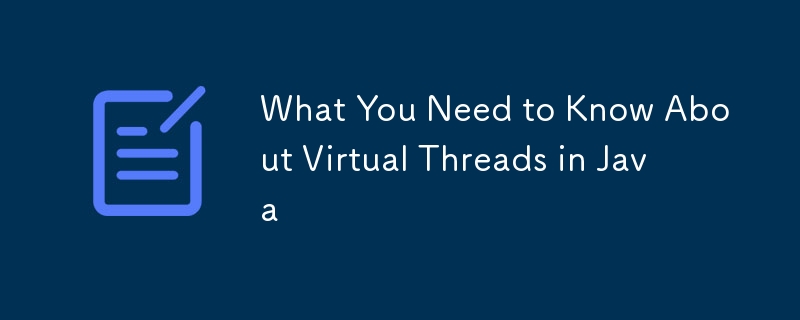

Virtual threads are a lightweight concurrency abstraction introduced in Java to address the challenges of managing a large number of threads efficiently. Unlike traditional threads, virtual threads are designed to handle a vast number of concurrent tasks without incurring the overhead associated with operating system threads.
Virtual threads are part of Java's Project Loom, which aims to simplify concurrency by providing a more scalable and efficient threading model. They allow developers to create thousands or even millions of concurrent tasks without the usual performance costs.
Virtual threads are implemented with a focus on improving scalability and performance in concurrent programming. Here's how they work:
Virtual threads are scheduled by the JVM rather than the operating system. This allows the JVM to manage context switching and execution more efficiently, reducing the overhead associated with traditional thread management.
Virtual threads use a cooperative scheduling model. Instead of preemptively switching between threads, they allow threads to yield control voluntarily. This reduces context switching and improves performance in certain scenarios.
Virtual threads integrate seamlessly with existing Java APIs. You can use them with familiar constructs likeExecutorService,CompletableFuture, andForkJoinPool, making it easier to adopt virtual threads in existing codebases.
Let's explore some practical examples and demos to illustrate how virtual threads can be utilized in real-world scenarios.
Here's a simple example of using virtual threads to handle HTTP requests:
import java.net.InetSocketAddress; import java.nio.channels.AsynchronousChannelGroup; import java.nio.channels.AsynchronousServerSocketChannel; import java.nio.channels.AsynchronousSocketChannel; import java.util.concurrent.Executors; public class VirtualThreadHttpServer { public static void main(String[] args) throws Exception { var threadGroup = AsynchronousChannelGroup.withThreadPool(Executors.newVirtualThreadPerTaskExecutor()); var serverChannel = AsynchronousServerSocketChannel.open(threadGroup); serverChannel.bind(new InetSocketAddress(8080)); while (true) { AsynchronousSocketChannel clientChannel = serverChannel.accept().get(); Thread.startVirtualThread(() -> handleClient(clientChannel)); } } private static void handleClient(AsynchronousSocketChannel clientChannel) { // Handle client connection here } }
Let's demonstrate how virtual threads can handle a large number of concurrent tasks efficiently:
import java.util.concurrent.Executors; import java.util.concurrent.TimeUnit; public class VirtualThreadDemo { public static void main(String[] args) throws InterruptedException { var executor = Executors.newVirtualThreadPerTaskExecutor(); for (int i = 0; i < 1_000_000; i++) { executor.submit(() -> { // Simulate task work try { Thread.sleep(100); } catch (InterruptedException e) { Thread.currentThread().interrupt(); } }); } executor.shutdown(); executor.awaitTermination(1, TimeUnit.MINUTES); } }
Understanding the benefits and limitations of virtual threads can help in deciding when to use them effectively.
Virtual threads offer a powerful way to manage concurrency in Java, providing a scalable and efficient alternative to traditional threads. By understanding their implementation and practical applications, developers can leverage virtual threads to build more responsive and performant applications.
Read posts more at: What You Need to Know About Virtual Threads in Java
The above is the detailed content of What You Need to Know About Virtual Threads in Java. For more information, please follow other related articles on the PHP Chinese website!




